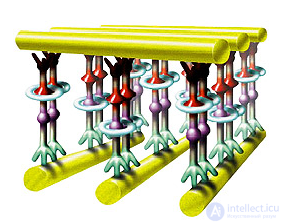Lecture
One more step has been taken in the creation of devices that will replace the modern silicon microcircuits in the foreseeable future. On January 23, 2002, Hewlett-Packard and the University of California, UCLA announced that they had received a US patent for the technology of creating complex molecular-level logic chips, the production of which, as they promise, will be simple and cheap.
Most experts believe that in about 10 years, silicon chip technology will reach the physical and economic limits of its development. Then the cost of building a plant for the production of advanced processors will amount to $ 50 billion against the current $ 2 billion. Therefore, an intensive search is now under way for cheaper technology that can ensure the development of more compact, faster and less power-consuming computing devices. One of the directions is the creation of keys consisting of several molecules.
From left to right: James Heath, Stanley Williams and Philip Cukes
U.S. Patent 6,314,019 B1 Molecular-Wire Crossbar Interconnect (MWCI) for Signal Routing and Communications ("Interconnect Switch with Molecular Wires for Signal and Communication Routing") issued to Philip Kyukes, Stanley Williams (HP Labs) and James Heath (UCLA) . This document represents an important milestone in the study, which is carried out under a grant from the DARPA agency with financial support from HP in the direction of molecular electronics development (moletronics, or nanoelectronics). The result of this work should be the creation by 2005 of a 16 Kbit memory device with cells in the form of individual molecules. Several important patents have already been obtained in this study. The modern process of manufacturing microcircuits includes numerous precise operations for the formation of a complex pattern of wiring computer circuits. The invention of HP and UCLA proposes the use of a simple array consisting of two mutually perpendicular groups of parallel conductors. Each conductor has a width of 6-10 atoms and a height of 2 atoms. At the intersection nodes are molecules, the state (and conductivity) of which may vary depending on the applied voltage. Such a molecule is an analogue transistor.
Employees of HP Labs previously demonstrated in the laboratory how nanoscopic parallel conductors are formed from some rare-earth elements by chemical interaction with a silicon substrate. From two sets of such conductors, perpendicularly oriented relative to each other, it is possible to form a grid.
In another experiment of the same series, the researchers built a grid of conductors having the same dimensions as the conductors in the chips of modern computers, and placed between them a monomolecular layer of electrically switched molecules - the so-called rotaxanes. When an electrical signal was applied to these molecules, a simple logic gate opened. For this invention, the team was awarded the Feynman Prize in the field of nanotechnology.
In addition, HP and the University of UCLA jointly patented a memory chip based on molecular switches. The Technology Review magazine, published by the Massachusetts Institute of Technology, called this patent (6,128,214, Molecular Wire Crossbar Memory) one of the five most important events in 2000.
"This work was the first to demonstrate the possibility of using molecules as electronic devices for computer logic circuits," said James Heath, a professor of chemistry at UCLA and director of the California Institute of Nanosystems.
“Its results prove that in the future programming can replace the sophisticated exact computer chip production methods that are currently in use,” said HP Labs senior researcher and system architect Philippe Kyukes. “After building the basic lattice by programming, you can implement a very complex logic circuit by setting up electrical signals the required switches in the molecular structure. "

The conductive properties of rotaxane molecules located at the intersection of the conductors depend on the position of the girdle ring
But although previous experiments have led to the creation of simple logic circuits, the main obstacle has not yet been overcome, which did not allow to realize all the advantages of the new technology and create more complex microcircuits that could be used in practice. "The problem was that in a single large grid All electrical signals are interacting, ”Stanley Williams, HP Labs director for quantum technologies, said.“ Imagine that all traffic lights in Manhattan are turned off and you are not allowed to drive at a speed of less than 30 mi or an hour — as a result, a huge traffic jam is formed. Segments of conductors, like traffic lights, regulate traffic, allowing you to move information (passengers) between any two points of the grid. " The new invention involves the division of conductors into short segments due to the transformation of some of the "intersections" in insulators. “You simply divide the city into several districts. Inside each district there will be small streets, and large ones will connect the districts among themselves,” explained Mr. Williams.
Insulators are obtained with the help of "cut-off conductors", which differ in composition from ordinary ones. The potential difference on the cutting and the main conductor and creates insulation.
The management of these voltages and charges last year was patented by Williams and Kyukes (US Patent 6,256,767, Demultiplexer for a Molecular Wire Crossbar), who developed a method for integrating molecular devices into the microcircuits currently produced, whose components are approximately two orders of magnitude larger. Simplified, this process can be represented as a special technology of demultiplexing, when using chemical processes microchips obtained by lithographic method are connected with conductors measuring several nanometers. As a result, a very important in practical sense problem of organizing effective input-output of information with respect to such molecular structures was solved. A similar problem for quantum computers has not yet been solved.
Apparently, the latest technological revolution in electronics is approaching: elementary devices are reaching the line of molecules, after which further movement in this direction will become impossible.
Comments
To leave a comment
History of computer technology and IT technology
Terms: History of computer technology and IT technology